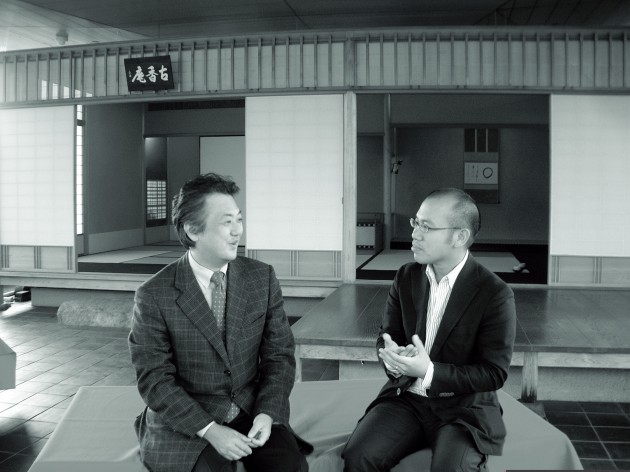Hosomi Yoshiyuki is the founding director of the Hosomi Museum in the Okazaki district of Kyoto. The museum houses a 1,000 piece art collection representing all major periods of Japanese art from the Jomon to Meiji, featuring 30 Important Art Properties.

Thank you for dinner the other night.
You’re welcome. We really enjoyed the drinks, didn’t we?
(Laughs) Yes, we did. The food was very good too. How do you think food in Kyoto is different than other parts of Japan?
Well, we talked about this before, but there is an idea of miyabi (elegance, grace) in Kyoto. For food, although taste is very important, it is also important to present it in an elegant way. I know this is common all over Japan now, but I feel this especially in Kyoto, even 25 years ago.
I can see that. How else has Kyoto has influenced Japanese food?
It’s not just presentation. You know, in Kyoto we have many counter-style restaurants where customers eat in front of the chef. Of course, they have sushi bars in Tokyo, but chefs here like interacting with guests, seeing and hearing their reaction to the food. This helps their cooking. And for guests, it becomes a richer experience than just eating food. Not just with sushi. This counter-style restaurant was invented in Kyoto, I think.
Interesting… didn’t you say Parisans have miyabi as well?
Yes, I feel so. I remember a chef friend of mine who trained in Paris. His teacher would say, “You’re a great chef but you lack elegance.” We didn’t understand that but now I think I do. It’s hard to explain miyabi but it’s a sensitivity to food, design, art, etc… understanding slight nuances. Kyoto people instinctively know this.
Do you consider yourself from Kyoto?
Well, I was born here actually and was raised here until I entered kindergarten when I started living in Osaka. But even in school I spent most holidays in Kyoto. So you can say I’ve lived in Kyoto for two thirds of my life.
What do you think has changed the most since then?
Good question… the biggest difference is that people don’t swim in the Kamogawa river anymore! (Laughs)
You used to swim in the river?
Well yes, we used to section-off a part of the river and swim there. What else has changed? After they stopped using tram cars, I felt a big change. There were more people on the streets, running for streetcars, so the overall atmosphere of the city has changed. But it’s funny: when I was in my twenties and thirties, I used to go to newest stores and restaurants. Now, in my fifties, I find myself going to places I know the most, not the new ones. I guess it’s a certain nostalgia for the past.
Speaking of the past, the museum is ten years old, but your collection was begun by your grandfather and continued by your father. How do you think they differ as collectors?
We actually have pieces from everything from the Jomon to early Meiji periods, but my grandfather, who began collecting in the 1930s, was very interested in Heian Buddhist painting, metalworks, and cloissionne — art until the end of the Momoyama period. My father, on the other hand, was one of the first to appreciate Rimpa/Edo painting. Me, I’m just the museum manager (laughs).
Why did you decide to build this museum in Kyoto, by the way? Because you also lived in Tokyo.
I guess when people think of Kyoto and Nara, they have an image of culture and history. And we were very lucky to find this location in Okazaki. It’s Kyoto’s “culture zone” with the Kyoto Municipal Museum, National Museum of Modern Art, Heian Shrine, etc.. being so close by. I felt we had this big art collection that I wanted everyone to see.
And now that I think of it, the museum’s collection has a strong relationship to Kyoto. The Rimpa school, for example, was born and developed here, and it’s a big part of your collection.
Yes, that’s right. Sotatsu, Korin, Koetsu… they all lived here. And Kyoto as a subject was often painted as well.
How did Kyoto influence the Rimpa style?
I think Rimpa comes from the decorative tastes of Hideyoshi. He lavishly patronized the arts: tea, textiles, painting, everything. On top of that you had a class of machishu (wealthy merchants) who did the same. The Koetsu family, who helped pioneer Rimpa, came from this background of design and craft.
The city of Kyoto is important to your philosophy, isn’t it? You seem to bring art to the city with the Campus Pass system (students of several Kyoto-based universities can enter for free.)
That’s true. Campus Pass has been really popular, and other museums have joined the program. We also hold tea ceremonies, seminars, and events in English like the ones you organize, Eric, not to mention our museum shop recently opened at Takashimaya department store. So yes, I really want to interact with the city more.
A bit like a chef at a counter restaurant?
(Laughs) Yes, yes.



